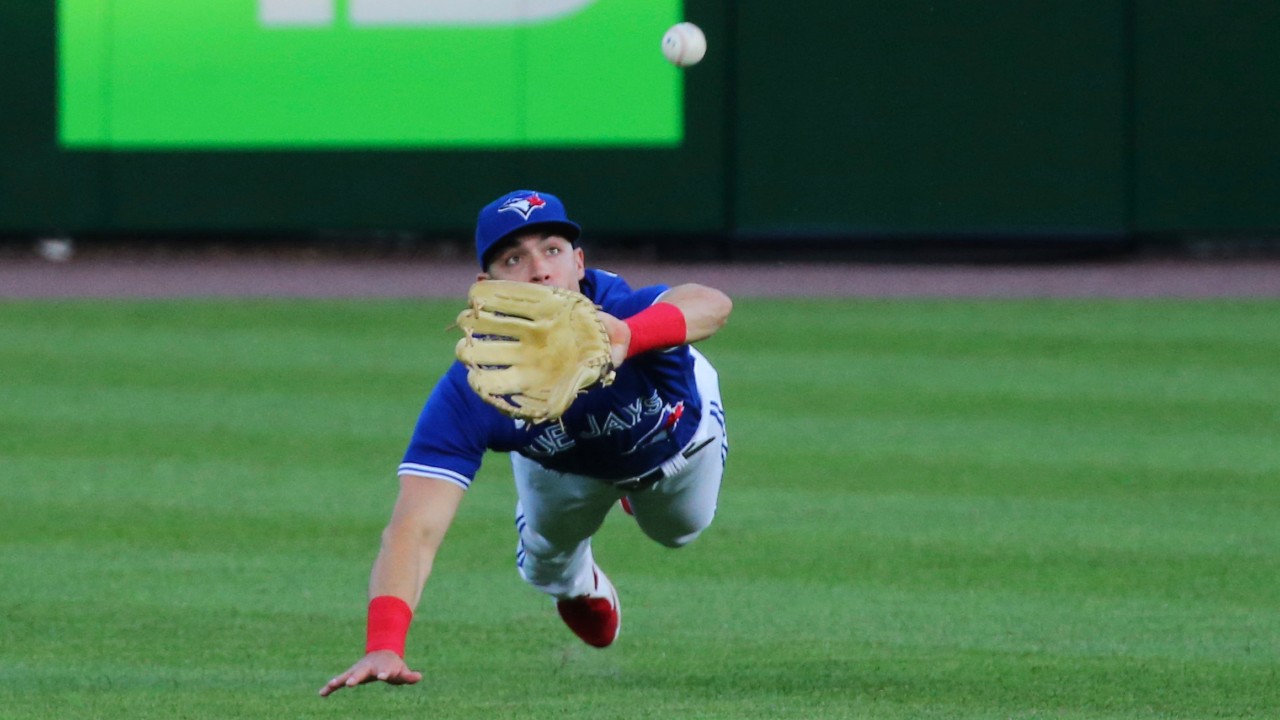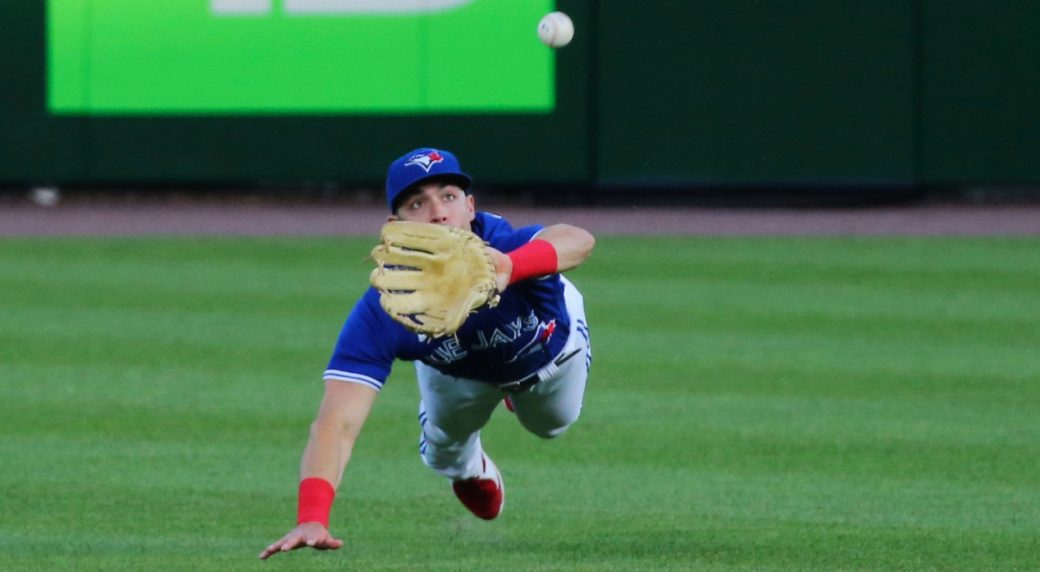

TORONTO — By any definition, the Toronto Blue Jays are a good baseball team but like every team in baseball they can — and should — look to make further improvements before opening day.
Their post-lockout shopping list will start on the infield and extend to the starting rotation and the bullpen. So in brief: the Blue Jays are a good team that will look to improve by addressing those clear remaining needs. We could leave it there.
Instead, let’s search a little deeper for weaknesses. Not because this Blue Jays’ roster has more issues than most (it doesn’t) but because defining those weak spots more clearly can hint at what’s ahead for the team’s front office. After all, for every shortcoming, there should be a corresponding opportunity to improve.
With that in mind, let’s go beyond the obvious and look for some smaller-scale upgrades the Blue Jays may want to consider …
Late-inning defence: A centre field glove
Back in 2016, George Springer played every single regular season game, mostly as a right fielder. He moved primarily to centre in 2017, but has started fewer games in centre each successive year:
2017: 79
2018: 73
2019: 67
2020: 41
2021: 40
Now 32, Springer’s still a viable centre fielder when healthy, capable of making the routine plays and even some spectacular ones. But his recent history suggests the Blue Jays also need a reliable alternate on the roster, too.
Not only could that player spell Springer in centre for extended stretches if needed, but his presence would also allow manager Charlie Montoyo to improve defensively late in games by removing Lourdes Gurriel Jr., a tactic the Jays often employed down the stretch in 2021.
For now, Randal Grichuk is that player, yet the way the Blue Jays used him late in 2021 suggests they may prefer him in a part-time role. In September, with the season on the line, Grichuk played only 11 complete games while playing partial games for another 12 as Jarrod Dyson’s presence cut into his playing time (Dyson appeared in 22 September games, compared to Grichuk’s 23).
Beyond Grichuk, the Blue Jays don’t have any sure things internally as Josh Palacios struggled in his initial opportunity at the MLB level, but there’s always the possibility of looking outside the organization.
In fact, the Blue Jays discussed a Jackie Bradley Jr. for Grichuk trade before the lockout, according to Ken Rosenthal of the Athletic. The Grichuk-for-Bradley discussions suggest the Blue Jays like the idea of upgrading their outfield defence and hint at a willingness to move Grichuk, in which case another centre fielder is a must.
Around that same time, another longtime AL East fixture was reportedly available in trades: Kevin Kiermaier. While the Blue Jays and Rays have made trades before, the Jays were still rebuilding when they sent Eric Sogard to Tampa Bay in 2019. Three years later, trading a franchise icon like Kiermaier to a division rival may be a tough sell. Still, the Rays may be ruthless enough. And if Kiermaier did end up in Toronto, at least he’d already know the Jays’ signs.
Of course, if you’re looking to improve your outfield defence, you might also want to pursue trades for players a little younger than Bradley and Kiermaier. And generally speaking those players have flaws of their own or a very high price tag. As such, it’s certainly imaginable that Grichuk continues to fill this role in 2022.
Looking ahead: Dominant relief
Making the assumption that MLB’s playoffs are expanded under the sport’s next collective agreement, the Blue Jays will open the 2022 season as a likely playoff team. But the goal isn’t just to reach the playoffs; it’s to win once you’re there.
With that in mind, the Blue Jays would benefit from further relief help, even after adding Yimi Garcia. And there’s a case to be made for aiming high because the presence of multiple relief aces can certainly make life easier for a manager when a game — or even your season — is on the line in October.
Maybe Julian Merryweather stays healthy. Maybe Nate Pearson ends up in the bullpen. Or maybe the Blue Jays don’t mind shopping in this market mid-season. But prices will be high in July, especially since an expanded playoff field would result in more buyers and fewer sellers, so why not act now instead?
Collin McHugh, Kenley Jansen and former Blue Jay Ryan Tepera are among the more intriguing free agents remaining.
Balance for Montoyo, part 1: A lefty bat
Ideal-world, the Blue Jays would acquire an infielder who switch hits or bats left. Switch hitters Jose Ramirez and Ketel Marte are ideal fits, for instance, and while the positional fit isn’t quite as clean with lefty bats like Michael Conforto and Kyle Schwarber, that shouldn’t stop the Jays from exploring.
By adding a lefty or switch-hitting bat to the top half of their lineup, the Blue Jays would make life harder for opposing managers. Thinking of trying a right-handed opener? Or using a low-arm slot right-hander late in games? That becomes tougher if there’s a legit lefty bat in the lineup every day.
Even a bench bat would help Montoyo late in games, as we saw once the Blue Jays added Corey Dickerson last summer. With that in mind, the Jays could explore smaller-scale deals for lefty bats if they don’t land a prominent player to fill this need.
At the same time, handedness only tells part of the story …
Balance for Montoyo, part 2: More late-inning runs
On the whole, the Jays were an incredible offensive team last year, ranking third in baseball in runs scored and second in wRC+ and strikeout rate. Like the Astros of recent years, they combined elite power with contact skills for a balanced offensive attack.
Oddly enough, though, the Blue Jays’ offence dropped off late in games. For the first six innings of games, the Blue Jays led MLB with a 122 wRC+. But from the seventh inning on, they were 12th with a 91 wRC+.
After the season, GM Ross Atkins elaborated on the At the Letters podcast.
“Offence is not our problem,” he said. “We do not have to score more runs. I will say this, however: we were fantastic at putting runs on the board early in games. Against really high leverage relievers late in games we didn’t fare quite as well as the league did. I think we were 18th or 19th against really high leverage relievers when they were matching up against us late in games. And I would, if possible, like to have more opportunities to not be matched up quite as well.
“But in the end, right-handed or left-handed, that’s not our problem. We obviously did not struggle to score, it’s more about having different scenarios to combat the way we’re being attacked if possible.”
To some extent, this is likely the product of small sample randomness. It’s not as though opposing relievers will be eager to face the Blue Jays late in games this coming year. But it also suggests the Blue Jays were easier to match up against than they should have been. In the playoffs, that could be a problem.
Adding a left-handed bat could help on this front and a right-handed hitter with a strong track record against elite velocity and movement could work equally well. One way or another, the Blue Jays will want to find ways to nudge those close and late scores in their favour this coming year.
Potential weaknesses on Blue Jays’ roster and how to solve them
Source: Pinas Ko Mahal

0 Mga Komento